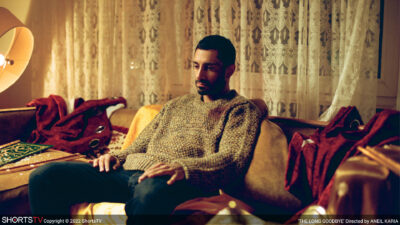On April 1 we’ll open THE ROSE MAKER at the Claremont, Playhouse, Royal and Town Center. Catherine Frot stars as one of France’s greatest artisanal horticulturalists, whose rose business is on the brink of bankruptcy. When her secretary hires three inexperienced ex-convicts, they must team up to rescue the business in this verdant comedy. Enjoy this clip for a whiff:
Moviegoers, last chance to catch the Oscar nominated films in theatres.
Stand with Ukraine through Film: THE GUIDE and Ukraine War relief.
We all know of the tragedy that is happening in Ukraine because of the Russian invasion. Thousands of civilians are dying in the streets while as of today 3,000,000 people are fleeing the country.
Film exhibitors around the country want to do their small part. Working with filmmaker Oles Sanin, who is currently in Ukraine, we have banded together to screen his 2014 Ukrainian film The Guide and will donate 100% of the proceeds to help his fellow Ukrainians. We’ll begin screening the film this Friday at the Monica Film Center. The Guide follows an American boy named Peter and and a blind minstrel, Ivan, who are thrown together by fate during the Stalin-perpetrated genocide in 1930s Ukraine.
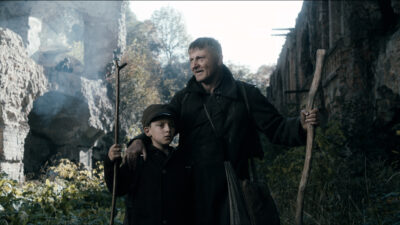
Here’s the official website: STAND WITH UKRAINE THROUGH FILM
Here is a message from the director that will precede the screenings:
Here is the film’s trailer:
“Solidarity is a magnificent way to reinvent oneself.” Catherine Frot on her role in THE ROSE MAKER, opening April 1 at the Playhouse and Royal.
The French rightly pride themselves on their artisanal traditions, from fine wines to bread, cheeses and more. That storied culture is increasingly at odds with modern, massive corporations trying to maximize profits, which can radically reduce quality. (This recent Guardian story about baguettes is a case in point.) The “lovingly made light drama” The Rose Maker dramatizes this dynamic. The film follows Eve, one of France’s greatest artisanal horticulturalists, whose rose business is on the brink of bankruptcy. When her secretary hires three inexperienced ex-convicts, they must team up to rescue the business in this verdant comedy. The movie is “a tender dramedy about apprenticeship, striving for excellence, and the passing down of savoir-faire.” (City of Lights, City of Angeles Film Festival)
Lead actress Catherine Frot was recently interviewed about her work on the film:
Q: What attracted you to The Rose Maker?
A: I was initially drawn to the character’s personality and also her arc: that of a woman who was a glory in her profession, who is no longer a glory but who will nevertheless experience a rebirth by accepting the help of people who have also hit rock bottom. People who are in trouble, locked in their solitude but who, despite their differences, end up finding their salvation in solidarity. I was first touched by the social dimension and the humanity of The Rose Maker. And then I realized that the roses were very important in the charm of this tale of helping hands, that they were even essential, that they gave it an indescribable poetry and a heady perfume. I must admit that I didn’t pay much attention to these flowers before. The film introduced me to them. I feel like I’ve made an extraordinary journey into an unknown land. I no longer look at roses in the same way. I know what their beauty requires in terms of care and know-how and today they touch me and make me dream.
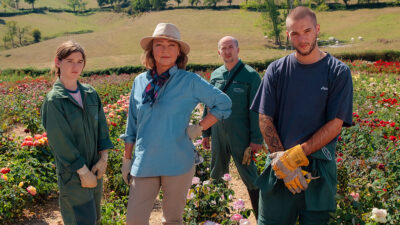
Q: Let’s get back to Eve.
A: For an actress, Eve is an irresistible character, because she is so complex and will evolve so much. At the start of the film, she is proud, upstanding, courageous, closed in on herself; a sort of uptight but bruised boss lady who only keeps going thanks to her “monomaniacal” passion for roses. She was a queen in her field, stronger competitors have taken her crown, and yet she continues to fight for the survival of her business with quite incredible panache. Eve is a bit like an oak. On the surface, she is as solid as a rock, and yet she is weakened by wounds she believes to be invisible: the death of her father, the decline of her business and… the anonymity into which she has fallen. The unexpected arrival of three people in search of identity and social integration is enough to make this stubborn woman give up, question herself, and let a feeling develop in her that, as a childless woman, she thought she would never be able to experience: that of passing something on. Playing someone who comes out of her shell and transforms herself is always exciting, all the more so if, as is the case here, she is driven by an exclusive and totally disinterested passion. In a certain way, Eve “takes after” roses. She lives only for the perpetuation of beauty, something completely useless, fleeting, obsolete and yet fundamental and primordial. Eve undergoes a sort of spiritual quest which borders on poetry and which also gives rise, at times, to a certain humor.
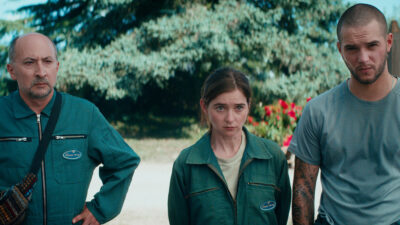
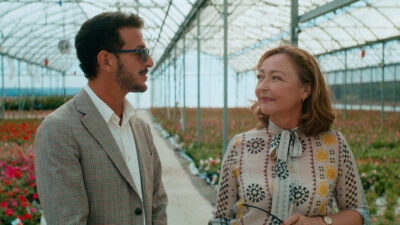
Q: Are costumes important for you?
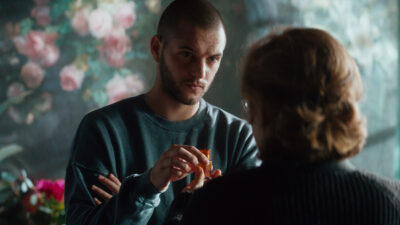
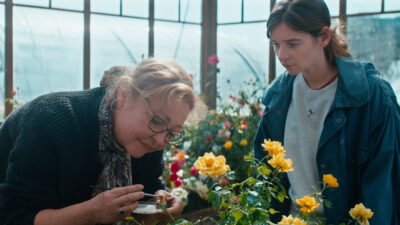
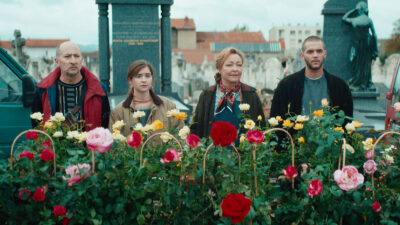
Pedro Almodóvar’s TALK TO HER: 20th Anniversary Screenings.
In celebration of Oscar season, Laemmle Theatres and the Anniversary Classics Abroad Series present the 20th anniversary of Pedro Almodovar’s Academy Award-winning TALK TO HER (2002) on Wednesday, March 23 at four Laemmle locations: Glendale, Newhall, Pasadena and West L.A. The internationally acclaimed Spanish filmmaker earned two Oscar nominations for this “bizarrely poetic tale of men in love with two women in comas,” for directing and writing, winning in the latter category. In the current Oscar race, Almodóvar’s most recent film, PARALLEL MOTHERS, has also earned two nominations, including a Best Actress nod for Penelope Cruz.
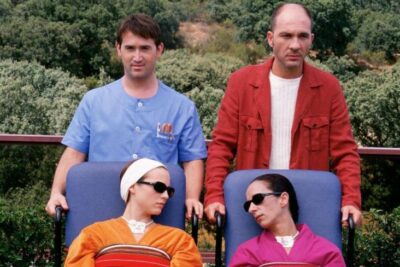
TALK TO HER is the story of a macho travel writer (Darío Grandinetti) and a gay male nurse (Javier Cámara) who form an unlikely friendship when they bond over a shared but separate devotion to two comatose women: a gored bullfighter (Rosario Flores) and a ballerina (Leonor Watling), respectively. Told in flashback, the film unfolds with a delicate balance of drama, comedy, and suspense, all trademarks of Almodóvar’s inimitable style. He had emerged in the 1980s with a liberating sensibility after the repressive Franco regime had ended in Spain. In a series of unconventional melodramas over the next four decades, he has explored identity, sexuality, friendship, family, desire, and passion, often with irreverent humor. TALK TO HER was his first effort in the 21st century and was greeted with universal acclaim.
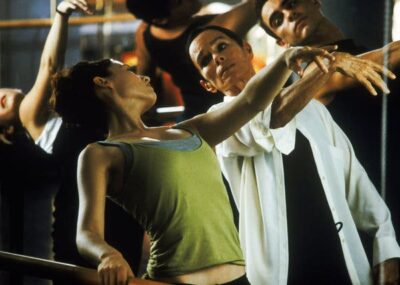
Among the plaudits, Roger Ebert extolled the “improbable melodrama…with subtly kinky bedside vigils and sensational denouements, and yet at the end, we are undeniably touched. No director since Fassbinder has been able to evoke such complex emotions with such problematic material.” Similarly, Philip French of the Guardian/Observer compared Almodóvar to past movie masters Ernest Lubitsch and Preston Sturges. The Guardian’s Peter Bradshaw also cited the film as “the most unmistakable auteur flourish in modern European cinema.” The film collected a multitude of accolades in addition to Oscar recognition, among which were Best Foreign Film prizes from the Golden Globes and National Board of Review. Almodóvar was also named Best Director of the Year by the Los Angeles Film Critics Association.
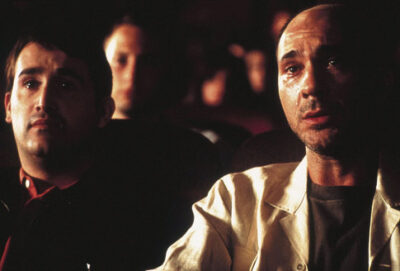
TALK TO HER plays one night only, Wednesday, March 23 at 7:00 PM at four Laemmle locations: Royal (West Los Angeles), Glendale, Newhall (Santa Clarita), and Playhouse 7 (Pasadena).
The Top Ten Films of 2021 contest results are in.
“Beautiful…timely” new documentary about Laemmle Theatres ‘Only in Theatres’ premieres at the Santa Barbara International Film Festival.
The new documentary about Laemmle Theatres, ONLY IN THEATERS, was begun just before the pandemic began and completed last year. It recounts the company’s history and features interviews with all the surviving players as they face the seismic changes in the film exhibition industry. The family members behind this multigenerational business—whose sole mission has been to support the art of film—remain determined to see it survive, despite enormous challenges. From the festival program:
“Laemmle Theaters, the beloved L.A. art house cinema chain, has an astonishing legacy with ties to the origins of Hollywood. This is a story about a family business and their determination to survive in the face of headlines that question the future of movie theaters. For more than 84 years and through three generations, this family’s personal mission has been to elevate the art of films and the artists who make them.”
ONLY IN THEATRES premieres this Saturday night at the prestigious Santa Barbara International Film Festival. There is a second screening on Monday, March 7. Programming Director Claudia Puig was quoted in the L.A. Times today calling it “a beautiful film, and a timely one.”
Follow the film on Facebook for updates on future screenings at https://www.facebook.com/onlyintheaters and check out the trailer:
Moviegoing safely.
- « Previous Page
- 1
- …
- 29
- 30
- 31
- 32
- 33
- …
- 100
- Next Page »

